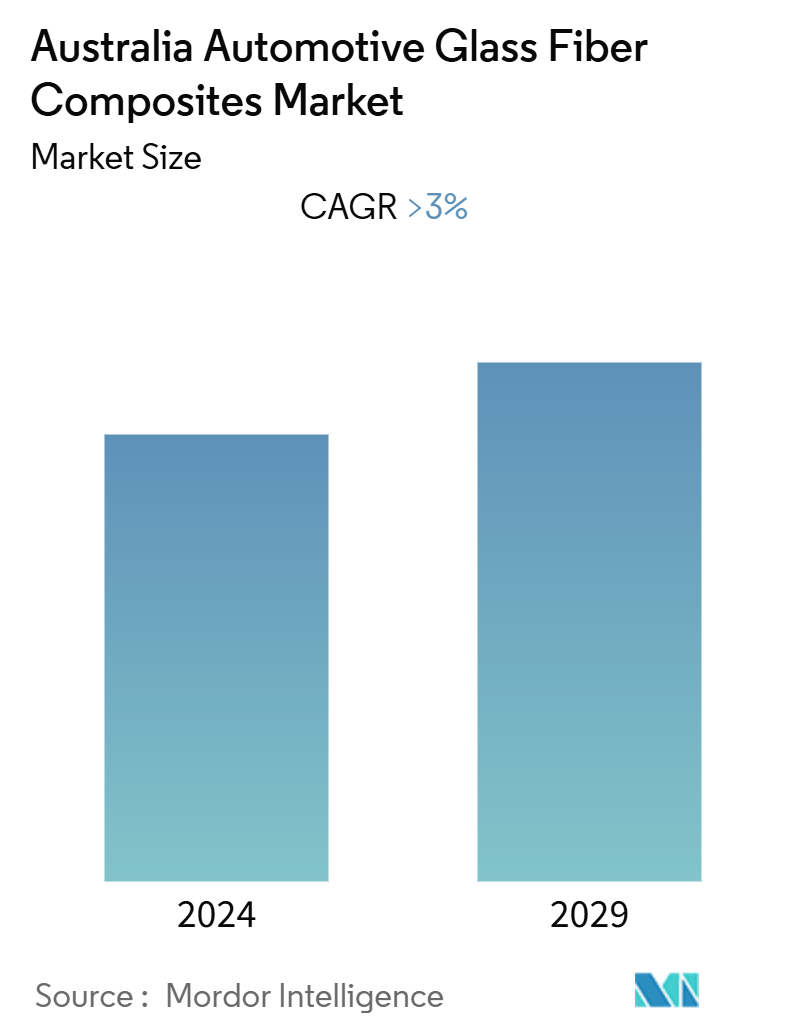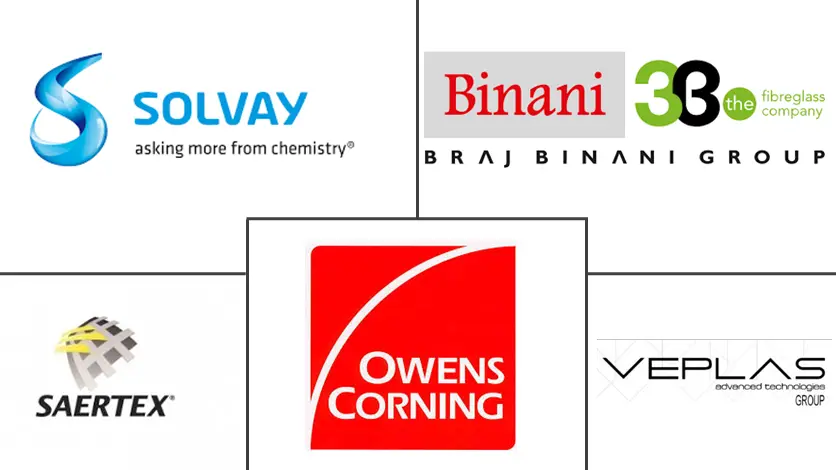
| Study Period | 2019 - 2029 |
| Base Year For Estimation | 2023 |
| Forecast Data Period | 2024 - 2029 |
| Historical Data Period | 2019 - 2022 |
| CAGR | 3.00 % |
| Market Concentration | Medium |
Major Players
*Disclaimer: Major Players sorted in no particular order |
Australia Automotive Glass Fiber Composites Market Analysis
The Australia Automotive Glass Fiber Composites Market is expected to register a CAGR of greater than 3% during the forecast period.
- The major growth drivers associated with this market are the rise in automotive production and the increasing demand for durable and lightweight materials because of stringent government regulations to reduce greenhouse gas emissions
- The future of the global automotive glass fiber composites market looks bright with opportunities in different automobile applications, such as interiors, exteriors, structural assembly, power-train and engine components, electrical and electronics, and others. The market for glass fiber composites in automobile structures is expected to be the fastest-growing segment, due to the wide variety of applications.
- Strategic alliances between car manufacturers, glass fiber and resin suppliers are the trends that have a direct impact on the dynamics of the automotive composites industry. Within the intermediates type, short fiber thermoplastic (SFT), long fiber thermoplastic (LFT), and continuous fiber thermoplastic (CFT) are the major ones that are used in automotive applications. SFT is expected to be the largest market by value, mainly driven by applications in power-train and engine components applications, which feature small complex-shaped components.
Australia Automotive Glass Fiber Composites Industry Segmentation
The Australia automotive glass fiber composites market covers the latest trends and technological development and market demand by intermediate type, application type, and market share of major automotive glass fiber composites manufacturing companies across Australia.
| Short Fiber Thermoplastic (SFT) |
| Long Fiber Thermoplastic (LFT) |
| Continuous Fiber Thermoplastic (CFT) |
| Other Intermediate Types |
| Interior |
| Exterior |
| Structural Assembly |
| Power-train Components |
| Other Application Types |
Australia Automotive Glass Fiber Composites Market Size Summary
The Australian automotive glass fiber composites market is poised for growth, driven by the increasing production of vehicles and the demand for lightweight, durable materials. This demand is largely influenced by stringent government regulations aimed at reducing greenhouse gas emissions. The market is expected to see significant opportunities across various automobile applications, including interiors, exteriors, structural assemblies, and engine components. The segment focusing on glass fiber composites in automobile structures is anticipated to experience the fastest growth due to its diverse applications. Strategic partnerships between car manufacturers and suppliers of glass fiber and resin are shaping the industry's dynamics, with short fiber thermoplastic (SFT) being a key component due to its application in complex-shaped engine parts.
Advanced materials like glass fiber composites have become integral to modern vehicles, enhancing fuel efficiency and maintaining performance and safety. These composites offer several advantages over traditional materials like steel, including corrosion resistance, chemical resistance, and reduced weight, making them ideal for use in various automotive components such as bumpers, hoods, and brake pads. Despite challenges such as a slowdown in automobile sales due to global trade tensions and the COVID-19 pandemic, the market is expected to recover with government stimulus measures. The market is consolidated, with major players like Solvay Group, 3B (Braj Binani Group), and Owens Corning, alongside smaller players in the Asia-Pacific region focusing on aftermarket products.
Australia Automotive Glass Fiber Composites Market Size - Table of Contents
1. MARKET DYNAMICS
- 1.1 Market Drivers
- 1.2 Market Restraints
-
1.3 Industry Attractiveness - Porter's Five Forces Analysis
- 1.3.1 Threat of New Entrants
- 1.3.2 Bargaining Power of Buyers/Consumers
- 1.3.3 Bargaining Power of Suppliers
- 1.3.4 Threat of Substitute Products
- 1.3.5 Intensity of Competitive Rivalry
2. MARKET SEGMENTATION
-
2.1 By Intermediate Type
- 2.1.1 Short Fiber Thermoplastic (SFT)
- 2.1.2 Long Fiber Thermoplastic (LFT)
- 2.1.3 Continuous Fiber Thermoplastic (CFT)
- 2.1.4 Other Intermediate Types
-
2.2 By Application Type
- 2.2.1 Interior
- 2.2.2 Exterior
- 2.2.3 Structural Assembly
- 2.2.4 Power-train Components
- 2.2.5 Other Application Types
Australia Automotive Glass Fiber Composites Market Research Faqs
What is the current Australia Automotive Glass Fiber Composites Market size?
The Australia Automotive Glass Fiber Composites Market is projected to register a CAGR of greater than 3% during the forecast period (2025-2030)
Who are the key players in Australia Automotive Glass Fiber Composites Market?
3B (Braj Binani Group), Owens Corning, Solvay Group, Veplas Group and SAERTEX GmbH & Co.KG are the major companies operating in the Australia Automotive Glass Fiber Composites Market.


